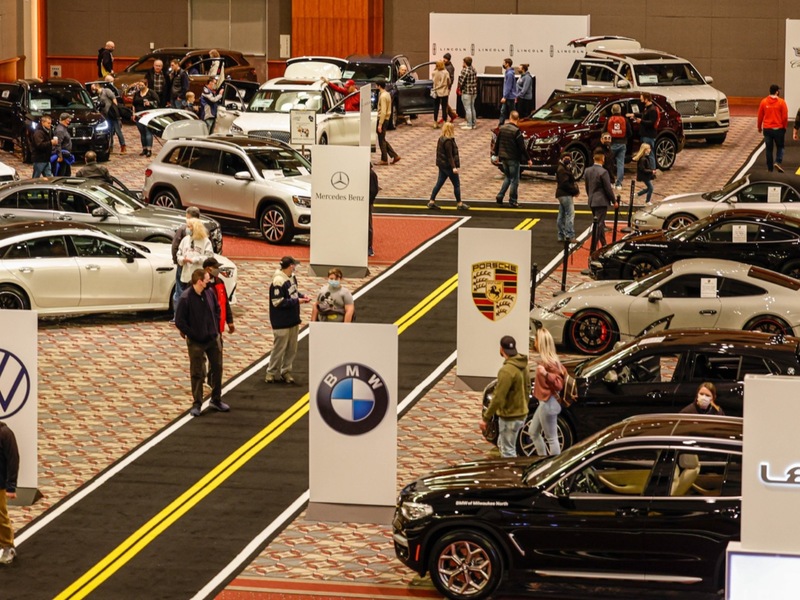This content is presented in partnership with ADAMM.
Of all of today’s vehicles that have been around a long time, the Dodge Charger may have had the strangest journey.
Born as a sleek street monster at the height of the muscle car mania of the 1960s, it eventually morphed into dowdy luxury sedan and, finally, into a small, inexpensive economy car before disappearing from the scene.
And then, after two decades, it roared back into the public eye – not only with retro-muscle car looks and performance, but also luxury sedan comfort, good gas mileage and a price tag that’s below the average for a new vehicle.
Call it a muscle car for everyone.
“It’s advertised primarily as a muscle car, but it’s not only a muscle car,” says Howard Robinson, sales rep for Ewald Chrysler Jeep Dodge Ram in Franklin. “It appeals to people who want power, but also need to fit in two car seats.”
Eric Rzentkowski, general manager for Russ Darrow Chrysler Jeep Dodge Ram of Milwaukee, agrees with that assessment, adding that “through the years, whoever’s owned Chrysler knew what they had in their muscle cars, that what they were building was timeless. The Charger today sticks very close to what’s always made those cars special.”
The Chrysler Corp.’s muscle car cred dates back to the 1955 Chrysler C-300, which Topspeed.com describes as “the fastest and most powerful production model in America at the time.” It also offered “enhanced luxury and comfort,” while sporting a V8 with twin four-barrel carburetors and a racing spec camshaft that put out 300 hp.
The Charger made its debut 11 years later. Designed in a wind tunnel, it was a fastback with “Coke bottle curves” and hidden headlights that gave it a menacing visage. It broke conventions with an interior that had four bucket seats split by a full-length center console. Engine choices ranged from a modest 145-hp six-cylinder to massive Hemi and “Magnum” V8s that cranked the horses to well over 400.
“The sound of the Hemi is unmistakable,” Motor Trend wrote at the time. “It isn’t really loud, just powerful. It gives goose pimples to enthusiasts and fits to the competition at the track.”
In 1971, though, stricter emissions and fuel-efficiency standards forced Dodge to scuttle the 7-liter hemi. And then, over the next four years, muscle cars fell out of favor with buyers, and Charger was reimaged as a bug-eyed “personal luxury coupe” with a landau “faux-convertible top.”
Says DriveTribe.com, “Dodge seem to have confused the Charger with an unprepossessing frog.” Sales plummeted, and three years later, Charger went on hiatus for the first time.
It did all right in the marketplace when it returned in 1981, but underwhelmed reviewers and people who craved fast, powerful cars. The new iteration, based on the subcompact Dodge Omni and in no way resembling the original, had front-wheel drive – which some critics called “wrong-wheel drive.” The base engine put out 70 hp; the most powerful mill logged in at 107.
The Charger entered oblivion again in 1987 – but tales of its demise were premature. A Charger with glory-days looks and 21st-century safety, handling, comfort and performance upgrades met with rousing success when it hit showrooms in 2006.
This rear-wheel drive version, Motor Trend says, restored “proper muscle car proportions,” the “menacing crosshair grille” and the beloved roofline and Coke bottle curves. Engine options ranged from a 178 hp six-cylinder the SRT8’s 425-hp 6.1-liter Hemi V-8. A facelift in 2011 and regular tech updates since have built on the legacy.
Reviewing the 2021 model, Kelley Blue Book echoes local dealers in dubbing Charger a comfortable, roomy family sedan that is “capable of so much more” because of powerful V6 versions and available all-wheel drive.
Adding AWD a few years ago was a big deal, Ewald’s Robinson says. “It only kicks in when you need it, especially in winter, to keep everyone in the vehicle safe.”
The most powerful ’21 trim, the SRT Hellcat Redeye, boasts 797 hp, more than any other available production sedan in the world. According to BuzzDrives.com, it’s the fastest muscle car ever, with a top speed of 199 mph and a zero-to-60 time of 3.5 seconds, “putting it in a class with supercars like Ferrari and Lamborghini.”
That Redeye lists at $78,595 – about a third of the cost of the typical supercar. The “base” R/T with a 292-hp V6 – which KBB says is “more than adequate” for most drivers and has excellent muscle for passing and merging – gets 30 miles per gallon of gas on the highway and starts at less than $30,000. The lowest priced Charger with a V8 lists for $37,000.
KBB also says Charger’s high marks for safety, comfort, a large rear seat, front and rear legroom and “capacious” trunk make it a fine choice for families.
Robinson and Rzentkowski say the more powerful versions can double as track cars and family haulers.
“You might be someone who says, ‘I like going fast, but also might like to have my friends along with me now and then,'” Robinson says.
“AWD on a car that was synonymous with track performance opened the Charger to a wide range of buyers,” Rzentkowski adds. “It’s not like the Dodge Viper, which was a weekend car you’d automatically want to store in the winter. It’s an economical daily driver with impressive styling.”







